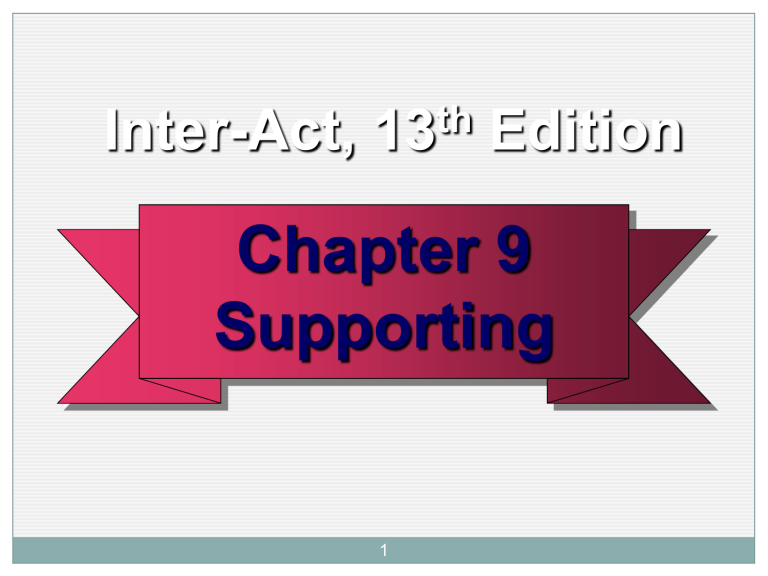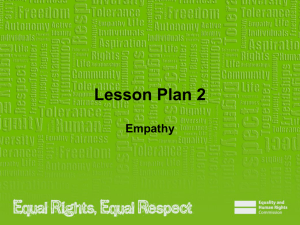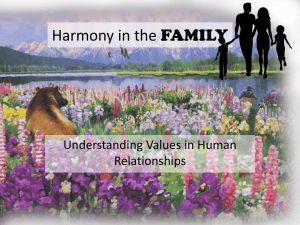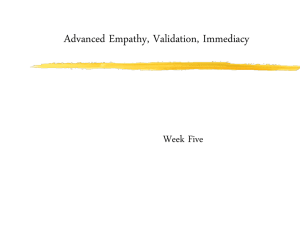Chapter 9 - Bakersfield College

Inter-Act, 13
th
Edition
Chapter 9
Supporting
1
Chapter Objectives
2
Explain the concept of empathy
Describe how to increase your ability to empathize
Discuss supportive messages
Describe the characteristics of effective and ineffective supporting
Explain the four phases of supportive interaction
Discuss the five message skills that will enable you to provide effective support to others
Discussion Question
3
Some people find it difficult to know what to say in times of crisis. Discuss appropriate and inappropriate responses to:
The death of a family member
The death of a pet
A divorce
A bad date
Discussion Question
4
Why do you think it is difficult for some people to provide helpful supportive messages?
Empathizing
5
The cognitive and affective process of perceiving the emotions others are feeling and then acting on our perception
3 Types of Empathy
6
Empathic Responsiveness
Perspective Taking
Sympathetic Responsiveness
Guidelines for Improving Empathy
7
Take time and make the effort to understand people.
Pay attention to nonverbal and paralanguage cues.
Pay attention to the emotional content of the verbal message.
Employ one of the three types of empathy.
Supportive Messages
8
Social support: providing emotional, informational, and instrumental resources
Supportive messages: communications that provide intangible support for your partner, including emotional support, information, advice, and motivation
Effective Support Messages
9
Clearly state the aim to help the other.
Express acceptance, love, and affection for the other.
Demonstrate care, concern, and interest in the other ’ s situation.
Effective Support Messages (cont ’ d)
10
Indicate that you are available to listen and support the other.
State that you are an ally.
Acknowledge the other ’ s feelings and situation and express sincere sympathy.
Assure the other that feelings are legitimate.
Encourage the other to elaborate.
Ineffective Support Messages
11
Condemn and criticize the other ’ s feelings and behavior.
Imply that the other ’ s feelings are not warranted.
Tell the other how to feel.
Focus attention on yourself.
Impose advice on a relative stranger.
Supporting Positive Feelings
12
Capitalization: sharing successes and leveraging the good feelings with the expectation that others will celebrate with us
Active-constructive: celebratory messages whose goal is to leverage partner’s positive feelings that stem from a happy event or accomplishment
Supporting Negative Feelings
13
Comforting messages: active, constructive feedback whose goal is to alleviate or lessen emotional distress
Supporting skills include empathizing.
Supportive Interaction Phases
14
Phase One: Support Activation
Phase Two: Support Provision
Phase Three: Target Reaction
Phase Four: Helper Responses
Clarifying Supportive Intentions
15
Directly state your intentions by emphasizing your desire to help.
Remind your partner of your commitment to the relationship.
Indicate that helping is your only motive.
Phrase your clarification in a way that reflects helpfulness.
Buffering Face Threats
16
Face-threatening act (FTA): a statement of support that a person in need may interpret as a threat to his or her public self-image
Positive facework: providing messages that affirm a person or a person ’ s actions in a difficult situation to protect his or her respectability and approval
Negative facework : providing messages that offer information, opinions, or advice to protect a person's freedom and privacy
Positive Facework
17
Describe and convey positive feelings about what the other has said and done.
Express your admiration for his or her courage.
Acknowledge the difficulty of the situation.
Express your belief that the other has the qualities and skills needed to endure.
Negative Facework
18
Ask for permission before giving advice.
Verbally defer to the opinions and preferences of the other person.
Use tentative language to hedge and qualify opinions and advice.
Offer suggestions indirectly.
Using Other-Centered Messages
19
Ask questions that prompt the person to elaborate on what happened.
Emphasize your willingness to listen to an extended story.
Use vocalized encouragement and nonverbal behavior to communicate continued interest.
Affirm, legitimize, and encourage exploration of feelings expressed by partner.
Demonstrate that you understand, but avoid changing the focus to you.
Framing
20
The skill of providing support by offering information, observations, and opinions that enable the receiver to better understand or see his/her situation in a different light
Giving Advice
21
Ask for permission to give advice.
Word the message as one of many suggestions in a way that the recipient can understand.
Present any potential risks or costs associated with the following the advice.
Indicate that you will not be offended if the other chooses to ignore your recommendation.
Social Support via Social Media
22
Advantages
Creates social distance
Hear from people around the world
Useful for introverted, shy, or lonely
Easier to manage messages
Crosses age/status/education boundaries
Time/place less important
Gender and Cultural Similarity
23
Desire to be comforted is universal.
Both men and women place high value on emotional support from partners.
Little difference reported between genders or among cultures
Culture
24
European-Americans believe that openly discussing feelings is valuable.
Americans are more sensitive to other-centered messages than are Chinese.
Chinese view avoidance strategies as more appropriate than Americans.
Chinese and American married people view emotional support provided by their spouses as most important.











